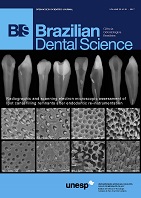Use of systemic antibiotic therapy after the replantation of avulsed permanent teeth: a literature review
DOI:
https://doi.org/10.14295/bds.2017.v20i1.1307Abstract
Dental avulsion is the most severe type of dentoalveolar trauma, and the treatment of choice for this type of injury should be the replantation of the exarticulated tooth. After conducting a review of the literature and holding discussions with experienced researchers and clinical specialists from different areas, the International Association of Dental Traumatology (IADT) proposed a protocol for tooth replantation, including a recommendation for systemic antibiotic therapy (SAT) to reduce the risk of root resorption. Several antibiotics have been tested, but tetracycline and amoxicillin are, by far, the most commonly used drugs for avulsion injuries. This paper reviews the literature on the prescription of SAT in cases of immediate and delayed replantation of accidentally avulsed permanent teeth, based on a critical analysis of full-length papers retrieved from the PubMed/Medline, Bireme and SciELO electronic databases. Original research reports and literature reviews published in English-language journals between 1966 and 2016, and directly or indirectly discussing the relation between antibiotic therapy and the replantation of permanent teeth, were searched using “tooth avulsion,” “systemic antibiotic therapy” and “tooth replantation” as key words. The prescription of antibiotics for tooth replantation was found to be a controversial subject, and randomized clinical studies are needed to determine whether antibiotics for tooth replantation are actual indicated. Until the results of these studies become available, the recommendation is to use SAT for the management of permanent teeth replanted after an accidental avulsion. The best prescription option is tetracycline for 7 days, and the second best prescription option is amoxicillin for 4 to 7 days.
Downloads
Downloads
Additional Files
Published
How to Cite
Issue
Section
License
Brazilian Dental Science uses the Creative Commons (CC-BY 4.0) license, thus preserving the integrity of articles in an open access environment. The journal allows the author to retain publishing rights without restrictions.
=================




























